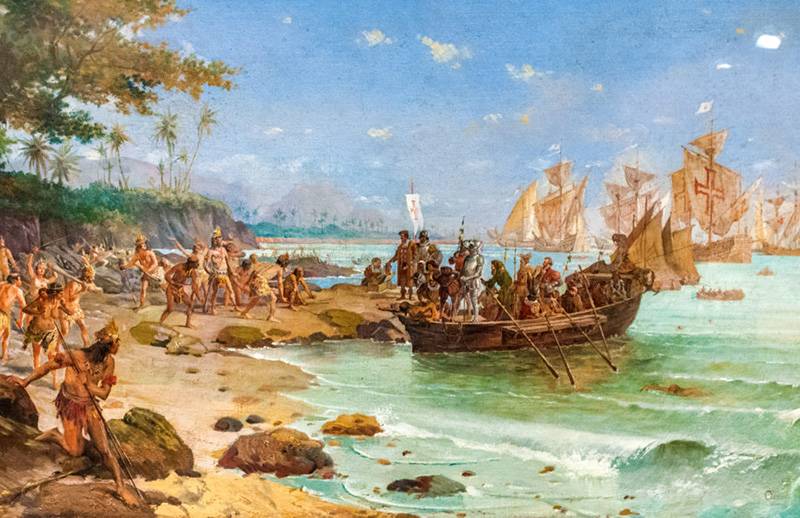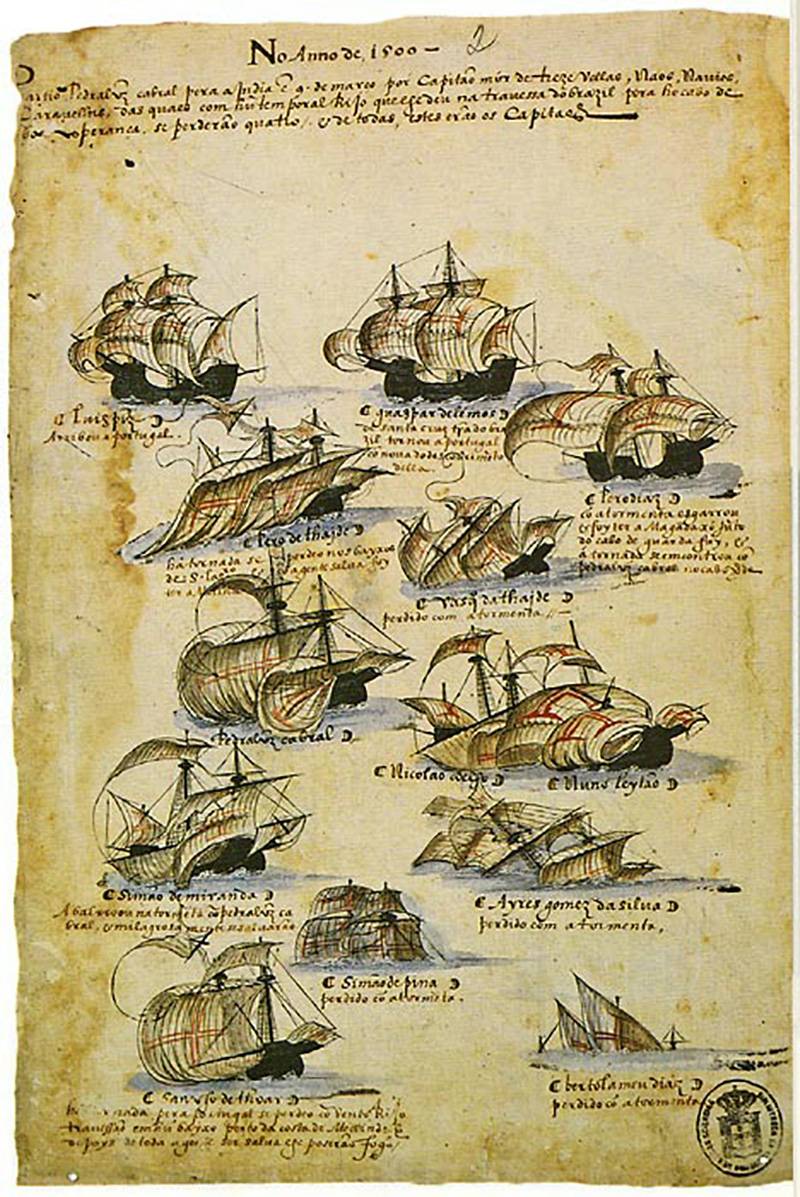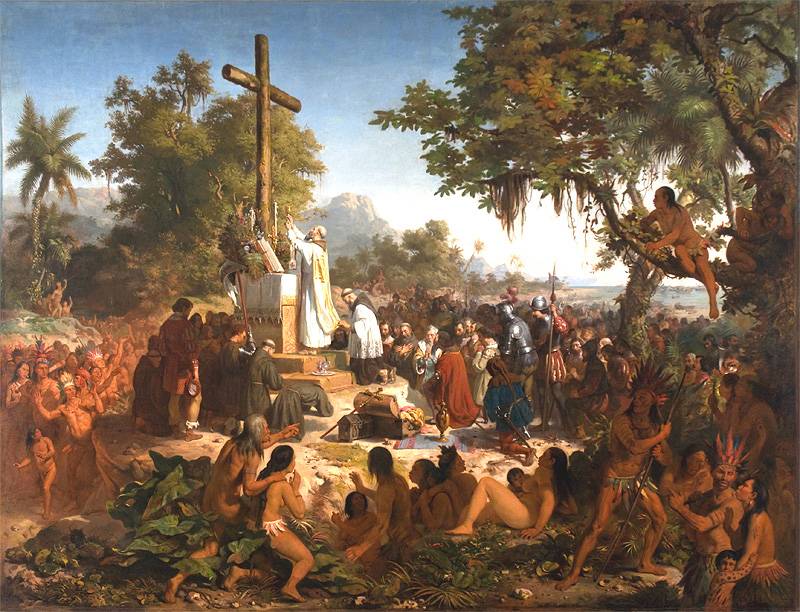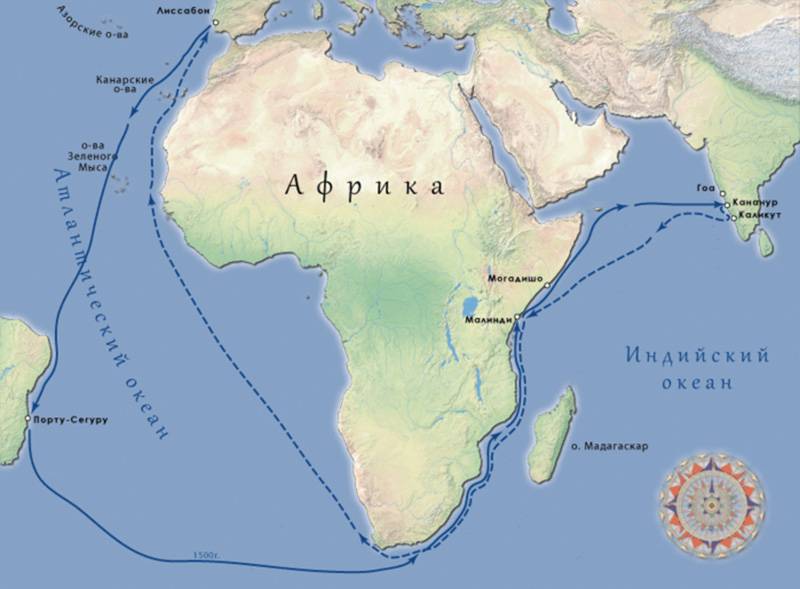According to the covenant of Heinrich the Navigator. Path to India: Cabral Expedition

Prince Enrique rightly believed that the path to the east would be the direct route that would lead his country to riches and greatness, transforming it from the provincial European outskirts into one of the main political players. In 1498, after countless efforts, the squadron under the command of the tireless Vasco da Gama finally reached Calicut. Almost a third of the expedition’s staff returned home, but a start was made. Now the leadership of Portugal in the face of Manuel I and his entourage sought to consolidate the initial success. The honorable duty to become the second after the stern Vasco da Gama fell to Pedro Alvarish Cabral.
Second
Lisbon again escorted the departing ships - not for the first time, and there will be many more such wires. The king, the motley crowd of courtiers — the rich outfits of nobles, who had already tasted colonial luxury, were diluted by the strict cassocks of the clergy, who also had their share in overseas trade. Gawkers, soldiers, solemn speeches, prayers and parting words. 9 March 1500 of the year 13 heavily laden ships left the mouth of the Tagus and began to slowly move towards the horizon.

This expedition was much more numerous and better equipped than the enterprise Vasco da Gama. The news that Moorish merchants were ruling the Indian Rajah’s court was greeted in Lisbon with a peculiar understanding. The enemy is old, the enemy is known, the Moors were unsafe in size even in faraway India. Therefore, the expedition included many military men - now, on occasion, it was possible not to fool around, seeming to be peaceful merchants looking for Christian countries, and without unnecessary ceremonies to remove steel blades from the sheath. Weapon it will have to be floated, even more so if the local authorities are not sufficiently intelligible about the undesirability of friendship with the unfaithful.
Of course, the Catholic Church could not leave such a large-scale enterprise as an expedition to India without its strict attention. And it is abundantly clear that the church as a comprehensive structure had its own interests in this matter, some of which, by the way, was very far from saving the soul and other theological studies. Because of such difficult circumstances, monastic robes were by no means a rare sprinkle of ships sailing on the decks. Numerous instructions received by Cabral indicated that before resorting to violent methods of influencing the Indian authorities, they should give the floor to representatives of the church, so that they would give the heretics and idolaters a chance to turn to the true faith.
The third important component of the expedition were merchants and other business people. In addition to the sword and the word there was another, equally effective factor - gold. Traders went to India to make deals, start a relationship and, of course, to make a profit. For many decades, if not centuries, the formula of colonial expansion: the soldier, the priest and the merchant - became the reference.
The head of such a large-scale project as an expedition to India, Pedra Alvarish Cabral came from a noble family that had long-standing roots. He did not have any outstanding services to the king except for the frequent presence in his entourage. Cabral was among the king's advisers, enjoyed the location and trust of His Majesty Manuel I. Vasco da Gama, who was the first of the Portuguese to reach India by sea, also took an active part in the preparation of the expedition. On his urgent advice, flotilla Cabral should not have moved along the west coast of Africa, which shortened the path, but assumed a fight against strong headwinds and currents, and picked up southwest.
South of the Cape Verde Islands should catch the northeastern passing winds and move up to about 20 degrees south latitude, and there, using the southeastern air currents, go to the Cape of Good Hope. It was assumed that such a route would, in spite of its apparent stretch, be faster. In addition, Vasco da Gama recommended that Cabral and his captains store fresh water not in barrels, but, following the example of the Arabs, in special wooden tanks, which lengthened the period of its preservation.
From experienced veterans, along with Cabral, Bartolomeu Dias, the first to reach the Cape of Good Hope, also sailed. He was supposed to be appointed governor of the gold deposits of Sofala on the east coast of Africa, which Vasco da Gama discovered on his expedition. True, Dias still needed to win this future service position, but no one doubted success. Among the closest advisers to Cabral was Nikolaou Coelho, an experienced ally of Vasco da Gama. In addition, as a connoisseur of local subtleties and morals in the expedition was attended by someone senor Gaspar da Gama. However, he became a seigneur relatively recently, since in reality he was a former Granada Jew Monsaid. After the fall of Granada, this man first moved to North Africa, then to Turkey. From there I got to India, where the donkey is. After a kaleidoscope of dramatic events, the former Granadian was on board the Vasco da Gama caravels and again found himself on the Iberian Peninsula. Sensing its importance and necessity, Monsaid decided to go to the Portuguese to profitable service, adopting Christianity.
Went to Calicut, and went to Brazil
Cabral ships went deep into the Atlantic — roughly March 22 left behind Cape Verde Island. Further the squadron went, more and more deviating to the southwest. Perhaps Pedro Alvarish Cabral too literally took the advice of Vasco da Gama and retired from the African coast a very significant distance. It can be imagined that the organizers of the enterprise had assumptions about the existence of a huge continent in the west, which de facto was under the influence of Portugal according to the agreement with Spain dated 1495.
In Lisbon, they knew that in 1498, Christopher Columbus discovered some impressive land west of Trinidad Island. Probably, there was a confluence of circumstances, to which everything is usually written off - both good and bad. After a month of being in the boundless ocean, on the 20 of April 1500, the crews of the ships began to notice increasing signs of the near land: large flocks of birds, algae, floating pieces of wood. Towards evening 22 April 1500 of the year ahead looking out from the crow's nest of the flagship with a loud cry announced land discovery.
After some time, a large cone-shaped mountain became noticeable. It was in the evening, and fearing that he was approaching the unfamiliar shore, Cabral ordered to anchor a few miles from land. The discovery was made on Wednesday of Holy Week, and the mountain discovered was immediately named Monte Pascual - Easter Mountain. The Portuguese took the land they had discovered as an island and designated it as Vera Cruz, the island of the True Cross.
At the head of the advanced reconnaissance detachment, Nikolaou Coelho landed on the “island”. He easily managed to establish contact with local natives, who gathered in abundance to gaze at the amazing big boats and even stranger tanned people dressed in outlandish clothes.
The establishment of diplomatic contact between the Portuguese and the aborigines was interrupted by sudden weather. A strong wind blew, the excitement rose. Coel and his men had to urgently return to the ships, after which Cabral gave the order to raise the anchors. He moved along the coast in order to find a comfortable and secure parking lot. A suitable bay was discovered in 40 miles from the site of the first landing. She received the name of Porto Seguro, which means Safe Harbor.

The Portuguese squadron stayed here for 8 days, doing preventive maintenance, preparing food and talking to friendly natives. The teams also needed rest before moving to the Cape of Good Hope. While enjoying the peace of a quiet corner of an exotic island, Cabral nevertheless did not forget about high politics. In order to secure for His Majesty Manuel I a new and possibly very vast territory, at the direction of the expedition commander, a cross was installed on one of the hills that dominated the bay. To exclude any doubts about nationality, the coat of arms of Portugal was carved on it. In order to impart solidity to the accidental discovery, in principle, Cabral decided to send one of his ships to Portugal under the command of Gaspard de Lemos with a thorough report to the king. In the message, the expedition leader described in detail the lands he had discovered, pointing to the friendliness of the local population and a large number of trees growing there. For the credibility of the captain was instructed to deliver to the court several parrots, whose appearance made a great impression on the Portuguese.
1 May 1500, the ship under the command of Gaspard de Lemos despatched to Lisbon with joyful news - it reached its destination safely. May 2 squadron Cabral left hospitable Porto Seguro and moved towards the Cape of Good Hope. For a long time, the land opened by him, without delay, by the way, adopted under the authority of Portugal, was called on the maps as the Land of the True Cross.
Subsequently, already new expeditions found a tree in this place, which produced yellow paint. This material was known in Europe for several centuries and was imported through numerous intermediaries from the East. Wood, which served as the raw material for the dye, was called brazil. Much later, it turned out that these were different, albeit related plants - the well-known to the Portuguese grew mainly in Malaysia. However, behind the land discovered by Cabral, the name that Brazil became well-known after years became firmly established.
To India and back
The passage across the Atlantic for Cabral’s squadron has become quite dramatic. At the end of May, in the area of the Cape of Good Hope, the ships hit a violent hurricane, which was preceded by almost a week of complete calm. The elements swept the ships - four of them died. On one of the ships Bartolomeu Dias found his death, the first of the Portuguese to reach the tip of Africa. The seafarers, who had lost sight of each other, had difficulty gathering along the shores of Mozambique.

Cabral gave the order, quite reasonable in those circumstances: to land on the shore and carry out repairs on the ships that were battered by storms. In total, under his command, there are six. One ship was lost at the beginning of the expedition for unknown reasons, another one was sent to Europe with the news of the discovery of Santa Cruz, four sank during the storm. The ship under the command of Diogo Dias, brother of Bartolomeu Dias, due to the damage received, fell behind and subsequently was in independent navigation.
Repairing a battered and halved flotilla took almost a month. Only 20 July 1500, leaving Mozambique astern, Cabral moved to India. Of course, due to the large loss of personnel, there could be no question of any capture of gold deposits on the way to the destination. The Portuguese pilots who knew the local waters were a great help to the Portuguese. With their direct help, 13 September squadron Cabral dropped anchor on the roadstead Calicut.
Almost immediately upon arrival, it turned out, to the deep chagrin of the merchants, though armed to the teeth, that the local situation more favored the start of hostilities than trade. The Arab merchants, who for a long time had very close economic ties with Asian countries, were by no means inspired by the emergence of competitors, and even dangerous and using weapons for any reason and without it at all. It was obvious that the relatively steady trade with the Indians came to an end; moreover, mediating functions in the supply of goods to Europe were now being questioned.
Vasco da Gama, during his first stay in Calicut, sent one of his sailors to the shore to study the situation (for such risky missions on an expedition, criminals were specially taken from prisons, who, besides the head, had nothing to lose). What was the surprise of the scout when the first Arab merchant he kindly asked him in good Castilian: “What the devil are you doing here ?!”
Of course, it was not at the mercy of the Arab business circles, to their great regret, that the Indian rulers could be barred from trading with the “infidels.” But something was possible to do. A propaganda campaign was launched, which clearly showed what is called “black PR” in the modern information world. Like Rajah Calicut, so did the Indian traders, the Portuguese and other potential aliens from Europe, in all their ugly abominations.
In fairness it should be noted that the campaign to blacken the Portuguese had a very real basis for it, so as not to be just a set of unsubstantiated accusations. The Arabs, however, were also very far from the honorary title of the most peace-loving people, but they were already regulars in India, and the Portuguese only groped for the way. True, the latter had the advantage of having serious arguments to prove their case in the form of bullets, cores and blades of excellent quality.
So, when Cabral's battered caravels reached Calicut, a cold reception awaited them. The local ruler, Samudriya Raja, whom the Portuguese called Zamorin for convenience, reluctantly allowed the newcomers to land on the beach and build temporary trading warehouses and shops. His impressions of Vasco da Gama’s previous visit were by no means rosy, but Calicut’s economy was based primarily on trade. Obviously, the desire to gain benefit prevailed over caution.
But the Arab merchant faction was not about to give up. They began to incite their Indian colleagues, eminent citizens, and simply the population did not buy or sell anything to the aliens. Passions ran high, and the Portuguese didn’t trade. In the end, an information campaign with correctly placed accents led to a public outburst, which can hardly be called spontaneous. A crowd of natives and Muslims attacked a temporary Portuguese trading post, defeating and setting her on fire. During the incident, several dozen Europeans were killed.
Cabral tried to achieve a sensible reaction of Samorin, but he pretended that he did not understand what he was talking about, and there was no response to the Portuguese commander’s message. Letting everything go its course and transfer the slaughter of compatriots into an innocent quarrel over a bunch of rotten bananas, mistakenly turned out to be ripe, was not in the tradition of the Portuguese when dealing with natives. The first word suddenly disappeared from the expedition's assignment as a commercial-military one, and the guns began to speak over the harbor of Calicut.
Prior to the "friendly bombardment" of neutral Copenhagen by Sir Horatio Nelson's multi-gun battleships was still very far away, but what was available to seniors from Lisbon in the last fall of the 15th century was enough for an Indian city. The boards of the Portuguese caravels were painted with smoke with the regularity that the technical thought of the late Middle Ages allowed. In Calicut, fires began, civilians died. In addition, several Arab merchant ships were burned, having had the misfortune to be in the harbor. To carry out a large-scale disembarkation and conduct accelerated courses on courteous treatment of “sahibs” Cabral lacked either the available forces or gunpowder. Raising the anchor, the squadron left Calicut, inhospitable for her.
Despite the Arab economic sanctions, the Portuguese managed to bargain for a certain amount of spices from the population. But this Cabral was not enough. Knowing how good-neighborly peace and unity reign among the coastal Indian cities, he sent ships to nearby harbors. They were Kannanur and Kochi. The rulers of these cities, of course, knew about the fierce newcomers on large ships from numerous Arab traders in these places. They also heard about the atrocities, cunning, and cunning of these heavily armed, peaceful travelers.
However, in Calicut, Raja Kannanur and Kochi saw, first of all, their own competitor, who was perhaps more dangerous for them than any bearded men with guns. In addition, one must take care of the integrity and fullness of the state (it’s also personal) treasury. Therefore, when Cabral offered mutually beneficial trade cooperation to the rulers and business circles of the cities adjacent to Calicut, they enthusiastically agreed. Such business pragmatism allowed respected Western partners to firmly fill their ships with spices, incense, expensive Indian fabrics and other valuable goods. In mid-January 1501, Cabral went home.
Return
The path was coming far and did not have to relax. In the area of Mozambique, one of the ships ran aground, and all attempts to remove it ended without success. The loser was completely unloaded, and his body burned. The Cape of Good Hope in evil irony again met the navigators with storms. The thinning flotilla was scattered, and only in June 1501, already in the Atlantic, off the African coast, Cabral managed to assemble four ships. Subsequently, it turned out that the fifth ship, the fastest, got to Lisbon on its own.
An unexpected encounter took place near the Cape Verde Islands: the Cabral flotilla met the ship Diogo Dias, who was lost in the middle of the storm on her way to India near the Cape of Good Hope. Then Brother Dias died - Bartolomeo. Considering the rest of the participants in the campaign were killed, Diogo Dias set off on an independent voyage, which had research rather than commercial goals. Moving along the African coast, he reached the entrance to the Red Sea, after which he decided to return.
Moving home, Diogo Dias discovered the islands of Reunion and Mauritius, visited the shores of Madagascar, and already on the way to the house he accidentally met Cabral with four ships. At the end of July, the 1501 of the year, an almost halved flotilla dropped anchor in Lisbon. Despite the losses, the mission of Cabral was declared successful, and he himself was generously rewarded and favored by King Manuel I. The total cost of the goods sold twice covered the large-scale expenses for organizing and equipping the expedition.
However, the details of the incident in Calicut expectedly led the monarch and his entourage into a state of righteous anger - the behavior of the Indians was deemed unacceptable. Inhospitable hosts required to punish, the Catholic clergy called to punish the heretics. Very soon, preparations began for a new, well-equipped and armed expedition to India. It was already clearly dominated by the military, and among the most important was the task of punishing Calicut for villains. The squadron was given the semi-official name “Fleet of Retribution”. At its head was to be an experienced, resolute and ruthless person. Not without following the labyrinth of court intrigues to this honorable post was erected by none other than Vasco da Gama, who was to once again reach the shores of Hindustan.
According to the covenant of Heinrich the Navigator. Path to India: Vasco da Gama, Cabral and others
Information